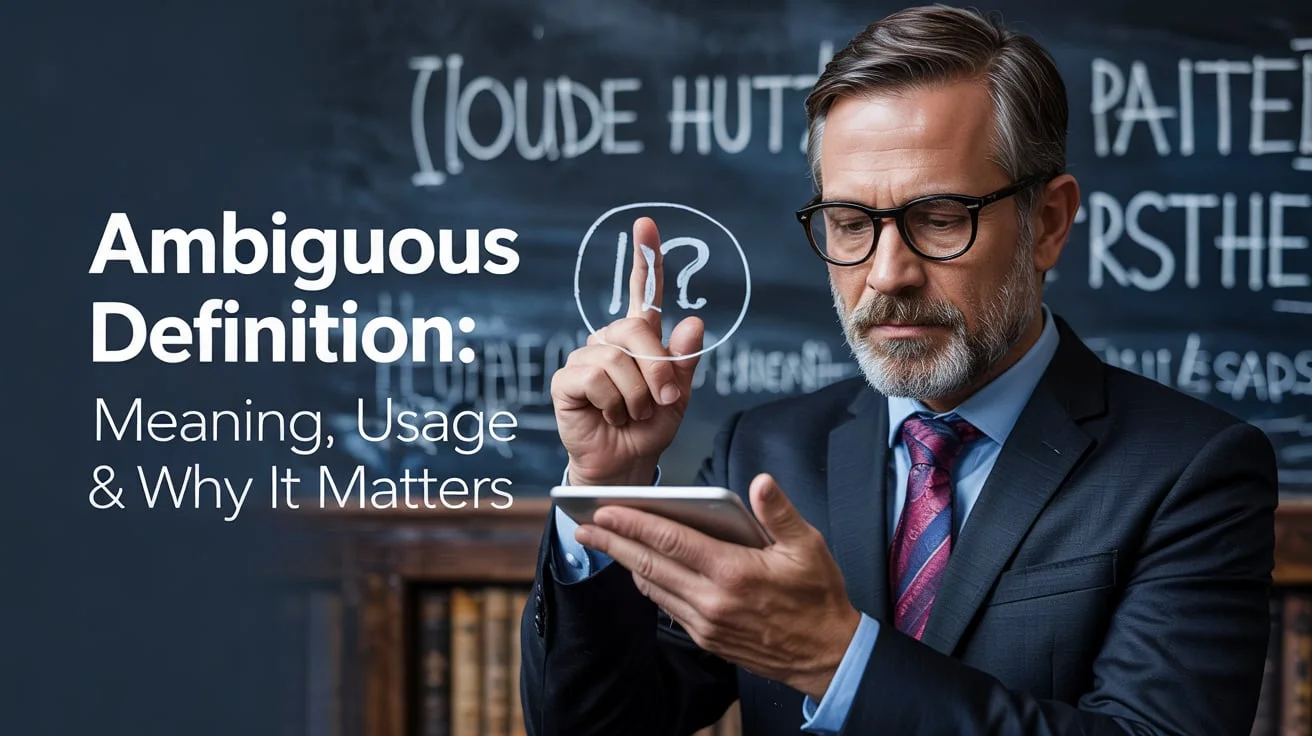Communication thrives on clarity. Yet ambiguity—when a phrase or word can mean more than one thing—creeps in all the time. Sometimes it sparks creativity, sometimes confusion. In this deep-dive article, you’ll uncover the true essence of ambiguous meaning, learn when it helps or hurts, and discover tools to spot and handle it in your writing, speech, and thinking.
Imagine sending an email saying, “Let’s meet early tomorrow.” Your colleague shows up at 6 AM; you meant 9 AM. That gap arises because “early” is ambiguous. Everyday, we stumble over phrases with multiple interpretations.
Ambiguity lurks in our language. Yet many people misuse or misunderstand “ambiguous.” By the end of this article, you’ll:
- Understand what “ambiguous” truly means
- Distinguish between kinds of ambiguity
- See how ambiguity plays out in law, literature, programming, and daily life
- Master strategies to clarify or use ambiguity deliberately
Let’s journey through definition, examples, implications, and practical advice.
What “Ambiguous” Means — The Core Definition & Its Nuances
Etymology & Word History
The word ambiguous comes from Latin ambi- (“around, both”) and -agere (“drive, lead”). So “ambiguous” originally implied something like “led in two directions.” Over centuries, it evolved to mean something with multiple possible meanings or interpretations.
In philosophical and linguistic texts, ambiguity often implies more than mere vagueness: it signals distinct, competing interpretations.
Standard Definition(s)
Here’s how dictionaries define related terms:
- Cambridge Dictionary: “a situation or statement that is unclear because it can be understood in more than one way.”
- Wikipedia (on ambiguity): “a phrase, statement, or resolution … not explicitly defined, making for several interpretations.”
- ThoughtCo / Nordquist: “Ambiguity happens when a sentence has more than one possible meaning at the same time.”
Key components in these definitions:
- More than one legitimate interpretation
- The interpretations must be distinct, not merely shades of the same meaning
- Context sometimes resolves ambiguity; sometimes it doesn’t
It’s crucial to distinguish “ambiguous” from words like vague, unclear, or equivocal. Ambiguity implies multiple coherent options, whereas vagueness implies lack of specificity without a clear boundary.
Types of Ambiguity
Ambiguity isn’t a single, monolithic concept. It appears in several forms. Here are the major ones:
| Type | What it is | Example | Notes |
| Lexical ambiguity | A single word has multiple meanings | bank (financial institution vs riverbank) | Sometimes called semantic ambiguity |
| Syntactic / Structural ambiguity | Sentence structure allows multiple parses | I saw the man with a telescope | Modifier “with a telescope” may attach to “saw” or “man” |
| Semantic / Pragmatic ambiguity | Word combinations or context allow multiple meanings | You have a green light (traffic, stage cue, permission) | Where context or speaker intention matters |
| Contextual ambiguity | Lack of background makes meaning unclear | “Let’s meet early”—when is “early”? | You need extra info to disambiguate |
In technical fields, you’ll even encounter scope ambiguity (multiple ways to interpret operators or quantifiers) or collective/distributive ambiguity (plural actions applied jointly or individually).
Related Terms & Distinctions
Here’s how ambiguous relates to—and differs from—similar words:
- Vague: lacks precise boundaries (e.g. “soon,” “some people”)
- Equivocal: intentionally ambiguous; often used to mislead
- Opaque / cryptic: hard to interpret; not necessarily ambiguous
Use ambiguous when a statement supports two or more coherent readings. Use vague when it lacks any clear boundary. Use equivocal when someone intentionally hides behind multiple meanings.
Usage & Real-World Examples
Ambiguity in Everyday Language
Language is layered. We meet ambiguity at nearly every turn:
- “We saw her duck.” → duck could be a bird, or the action of ducking
- “Let’s do lunch sometime.” → When? Where? Who pays?
- “He’s cool.” → Is he calm, stylish, cold, or aloof?
Such statements force your brain to pick meaning. Context often nudges you toward one interpretation.
Ambiguity in Professional Domains
Law & Contracts
Legal texts can be ambiguous by design or by accident.
- Contract clause: “deliver within a reasonable time” — what counts as “reasonable”?
- Ambiguous wording leads to litigation, contract renegotiation, or court interpretation.
Literature & Poetry
Writers often wield ambiguity deliberately:
- It invites readers to bring their own meaning.
- In The Turn of the Screw, scholars debate whether ghosts exist at all—ambiguity is central to the narrative.
- Poets leave space for dual readings, metaphorical depth, and multiple layers.
Politics & Rhetoric
Strategic ambiguity is a common tactic. Politicians use phrases with elastic meanings so different audiences hear different things.
Programming / Logic
In computer science, grammar ambiguity (ambiguous grammar) arises when a single string has more than one parse tree. That’s problematic in compiler design, so languages try to enforce unambiguous grammars.
Also, ambiguous logic or specification casts cause misunderstandings in system design.
When Ambiguity Helps & When It Hurts
Benefits of Ambiguity
- Creativity & depth: allows multiple readings, richer symbolism
- Flexibility: in diplomacy, phrasing can adapt to differing listener interpretations
- Irony & humor: puns depend on ambiguity
- Engagement: readers or listeners puzzle out meaning, staying more active
Risks of Ambiguity
- Miscommunication & misunderstanding
- Conflict (especially in contracts, laws, business deals)
- Loss of trust if speaker seems intentionally vague
- Errors in software or legal enforcement
Example (job posting):
“Must know relevant tools.”
One candidate assumes “Adobe Photoshop & Illustrator”; another assumes “Excel & Python.” Ambiguity caused misalignment.
Ambiguity vs Vagueness & Uncertainty
Let’s contrast:
- Ambiguity: multiple distinct meanings
- Vagueness: no clear boundaries
- Uncertainty: lack of knowledge whether any meaning holds
Case study:
Phrase: “He will arrive soon.”
- That’s vague: we don’t know how “soon.”
If someone said “He will arrive at 8 or 9 AM,” that’s ambiguous (two options).
If someone said, “I don’t know when he’ll arrive,” that’s expressing uncertainty.
Ambiguity and vagueness often mix, but smart writers, speakers, and thinkers aim to separate them.
The Deeper Essence & Implications of Ambiguity
What Ambiguity Reveals About Language & Thought
Language isn’t a perfect mirror of reality. It’s a tool shaped by context, convention, and human limitations.
- Words carry multiple meanings; we pick one based on context
- Compositionality: meaning builds from word meanings + structure. Different structures yield different meanings.
- Ambiguity shows that meaning is constructed, not fixed
Cognitive & Psychological Dimensions
How do humans handle ambiguity?
- Some people feel strong discomfort with ambiguity; others tolerate it well
- Creativity often thrives on ambiguity—unstated paths allow new connections
- Decision making under ambiguity leads to risk assessments, ambiguity aversion
Cultural, Social & Cross-Linguistic Aspects
- Some cultures prefer direct, unambiguous statements. Others embrace more poetic, ambiguous phrasing
- Translators face ambiguity loss: one language might force a single meaning where original allowed many
- Idioms often carry ambiguity across languages
Philosophical & Theoretical Angles
- In philosophy of language, ambiguity ties into questions about reference, meaning, and interpretation
- Philosophers like Wittgenstein emphasized how language can mislead when we ignore its limits
- Ambiguity touches epistemology: what we know, how we know, and how many possible interpretations reality allows
Read More: Context Definition: Understanding Meaning, Use, and Alternatives
How to Handle Ambiguity — Practical Advice & Tools
How to Recognize Ambiguity
Watch for these red flags:
- A sentence or phrase supports two or more coherent readings
- You hesitate, asking “Which meaning?”
- Unclear referents (like pronouns or modifiers)
- “Weasel words” like some people say, often, virtually—words used to dodge specificity
Quick test: Try rephrasing. If it forces you to choose one meaning, it was ambiguous.
How to Clarify Meaning
Here’s your toolkit:
- Use specific terms instead of general ones
- Add qualifiers (e.g. “within two hours,” “on weekends”)
- Insert parentheses or footnotes to disambiguate
- Ask for examples or context when reading someone else’s ambiguous phrase
- Use paraphrasing techniques: restate your meaning in a simpler way
When (and How) You Should Use Ambiguity Deliberately
Don’t always avoid ambiguity—sometimes it’s your ally.
- In creative writing, ambiguity invites interpretation
- In speeches or diplomacy, it allows different audiences to hear different things
- To soften strong statements, ambiguity can provide cushion
Cautions:
- Ensure essential meaning is still reachable
- Don’t rely on ambiguity to avoid responsibility
- Signal to your audience that you’re being intentionally open-ended
Tools & Frameworks
- Checklist for writers / editors
- Does this sentence allow more than one reading?
- If yes, is that intentional or harmful?
- Can I insert clarifiers?
- Would a reader reasonably misinterpret?
- Decision tree
Is the statement ambiguous?
— Yes → Can I clarify without losing tone?
—— Yes → Clarify
—— No → Keep (if artistic or strategic)
— No → Good - Software tools: grammar checkers (e.g. ProWritingAid, Grammarly) sometimes flag ambiguous phrasing, but human judgment remains essential
Conclusion
Ambiguity isn’t just a quirk of language — it’s a window into how meaning, context, and interpretation work. You now know:
- What “ambiguous” truly means
- How different types of ambiguity arise
- Where ambiguity is helpful, and where it breaks things
- Tools to detect and manage it
Next step: pick a text or email you wrote recently. Look for a phrase that feels murky. Ask: could someone interpret it differently? Then rewrite it.
Strive for clarity, but don’t fear ambiguity when it adds richness. Use both with intention and skill—and you’ll communicate more powerfully.

Founder of PunnyPeeks and master of celebration magic, David Mass is the creative spark behind the brand’s bold, balloon-filled brilliance. With an eye for color, a flair for design, and a passion for making people smile, David transforms events into unforgettable experiences. From quirky puns to perfectly curated party decor, he believes that every occasion deserves a splash of fun and a whole lot of heart.




